Owning a house means maintenance! Here are the common household maintenance guides and information for The Brownstones:
Below are links to the approved colors and materials for exteriors of The Brownstones.
Approved Exterior Brownstones Paint Colors by Sherwin Williams.
* Please note that for metal fences, the approved color is Rustoleum Gloss Black
Original exterior material/color matrix for each residence in The Brownstones.
Below is the approved light fixture for above the garages:
ELEVATOR MAINTENANCE
Here are two things that cause our elevators to stop working, and suggestions for dealing with them:
- There is a Uninterrupted Power Supply (UPS) battery located in the elevator control panel. The UPS battery has an expected life of about five years. When it dies, your elevator will not work. One sign that it has died is that the elevator ‘call’ buttons do not stay lit when you press one to ‘call’ your elevator. Elevator maintenance companies charge about $250 to replace this battery. A good plan is to replace this UPS battery as you get close to the five year mark. The original UPS battery is usually 450VA , but others with a higher rating such as 500VA or 600VA might have been installed. The UPS has a small battery inside that can be removed by opening the battery compartment and replacing it with a new one.
CAUTION: IF YOU ARE NOT KNOWLEDGEABLE ABOUT WORKING WITH ELECTRICITY DO NOT TRY THIS YOURSELF. - Whenever there is a power outage, or even a power surge, this can cause the elevator to fail. The usual sign that this has occurred – besides the fact that the elevator will not respond – is a whistling sound coming from the elevator control panel. This is a simple thing to fix, a simple ‘reboot’.
- Step one: Turn both of the large electrical supply box switches to the OFF position.
- Step two: Open the elevator control panel and turn the large UPS battery OFF. Do this by pushing the On/Off button on the top of the battery. You’ll know it has turned off when all of the lights in the panel begin turning off.
- Step three: Wait two minutes. Then turn both of the large electrical box switches back on, and then turn the UPS battery back on. All of the lights in the panel will begin to come back on.
- Step four: Wait three minutes and then push your elevator ‘call’ button to ‘call your elevator.
AIR CONDITIONING AND HEATING
Homes that have an air conditioning air handler in a fourth floor closet have to make a seasonal change in the spring and fall when changing over from cooling to heating and visa versa.
These homes have the following items on the fourth floor that need attention:
Ceiling Vents:The ceiling vents supply cool air to the fourth floor rooms when the air condition system is operating during warm months. They should be open. In fact, they should be left open all of the time (see below).
Floor Vents:Floor vents should be open when heating is on, but closed when the system is turned to cooling (see below)
Air Duct (in the closet):There is a large air duct the rises up from the air handler running up into the ceiling. There is a small lever on the front of that duct above the air handling unit. This lever operates a baffle inside the duct.
Settings when system is set to cooling:
When the handle is in the upright position (the 12:00 position) it allows air to flow up to the ceiling vents. This should only be in that position when the system is switched to cool air. This directs the cool air to the ceiling vents where it then falls to cool the fourth floor rooms (cool air falls, warm air rises).
The floor vents should be closed when the system is supplying cool air, for two (related) reasons. One, since cool air falls, any cool air coming out of the fourth floor floor vents will only cool the floor. And, two, by closing the floor vents, you cause the system to redirect that cool air to the ceiling vents in your third floor rooms.
Settings when system is set to heating:
The lever on the duct should be turned to the 3:00 position. This will close the baffle in the duct preventing the warm air from flowing to the ceiling vents. Since warm air rises, allowing warm air to flow to the ceiling vents would only result in warming the fourth floor ceiling.
The fourth floor floor vents should be opened to allow the warm air to enter into the fourth floor rooms (warm air rises), warming those rooms. It is not necessary to close the ceiling vents when the system is switched to heating because by closing the baffle in the air duct, the air can not flow to the ceiling vents.
FIREPLACE MAINTENANCE
The fireplace ignites electrically. When it fails to light the most common cause is the batteries in the unit below the fireplace need replacing. Open the door at the base of the fireplace to gain access to the battery pack. Replace the batteries with new ones and that should solve the problem.
When looking into that compartment you might find that the hole in the sheet metal side where the gas line enters has a draught of cold air coming in. That hole can be filled in using a can of spray foam used to fill holes and gaps. It expands and hardens into a solid piece of styrofoam. This product is available at Home Depot or Lowe’s.
If you use the fireplace a lot, the glass front will eventually become dirty from a collection of carbon on the inside of the glass. Fireplace stores sell a cleaner that will easily remove that accumulation of carbon.
DRYER VENTS
Clothes dryers are vented to the exterior of our houses. Over time they can become clogged with lint. This can cause two problems, the more serious one being a potential fire hazard. The other is that the efficiency of the cloths dryer is diminished. It is a good idea to have the dryer vent cleaned every few years.
CLEANING STOVE IGNITER
When turning on a stove top burner the igniter sometimes clicks continually before finally igniting the burner. This is caused by a buildup of carbon on the tip of the igniter element. Ignition occurs when a spark jumps a gap from the igniter to the base of the burner. A buildup of carbon on the igniter tip diminishes the intensity of the spark.
This is corrected by cleaning the igniter tip using a very fine piece of silicon carbide (for metal) sandpaper. To find the igniter take the grill off the burner and then lift the 2” round piece off – it’s not attached, it lifts right off. Then you’ll see the igniter tip, it’s a very thin 1” piece. Cut a small, narrow strip of sandpaper and use it by sliding it up and down around the igniter tip. It doesn’t take very much. Put the round piece back on and test it by lighting the burner. If it ignites right away you’re finished, if it still clicks too much, sand the tip a little more.
Our homes have multiple smoke alarms located throughout, as required by the building code. THESE SMOKE ALARMS ARE LOCAL ONLY, meaning if they are set off by smoke they will sound an alarm in the house, but they are not connected to any central station alarm system. Some homeowners have had central station monitored smoke alarms installed. There is an initial cost for the homeowner to have them installed, but there is no additional monitoring cost. Any alarm company serving the homeowner will install them.
The local smoke alarms are battery operated. When the batteries die the alarm begins beeping. The NFPA recommends that smoke alarms be replaced at least every ten years.
The 4-story homes in our community have fire sprinkler systems. The water that supplies the sprinkler system branches off from the line providing our domestic water supply. The water in the sprinkler lines remains there constantly, so over the years that water could contain contaminants that need to be kept from leaking into the domestic water supply. The device that controls that is a ‘backflow preventer’ and is located in your utility closet.
WSSC explains that the seals in the backflow preventers begin to fail after a period of five years. Therefore, WSSC requires annual testing of the backflow preventers OR replacement every 5 years.
Most plumbers do not have the necessary certification to perform that replacement. A specialist is required to do it. Durance Plumbing contact person, Kirk (202-359-4015) has done a number of them in our community.
Back-Flow preventer with red handle:
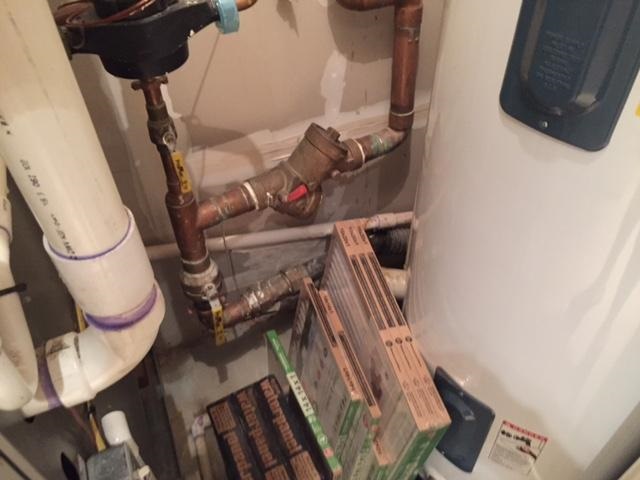
WSSC also prohibits the use of unmetered water that supplies the fire sprinkler system for any other purpose.
IMITATION SLATE ROOF SHINGLE PROBLEMS
The roofs on our homes have an imitation slate shingle on the front elevations (end unit homes have this slate on both front and rear elevations). With the exception of the end unit homes, all rear roof shingles are the more common asphalt, or fiberglass type, and these shingles appear to be in perfectly good condition.
The imitation slate shingle is a product manufactured by TAMKO, a major roofing materials manufacturer. This particular product name is ‘Laminite’ and it is a compound of resin and limestone. TAMKO discontinued making this product in 2007 . Many of our neighbors have discovered broken and missing slate shingles on their roofs and we have discovered many more during rooftop inspections. Some, but not all of this conditions have resulted in roof leaks. Many neighbors have already replaced the TAMKO product with a similar synthetic shingle produced by another manufacturer, ECOSTAR.
For original Brownstone owners, TAMKO offers a limited warranty, so anyone wishing to replace their slate shingles, should contact TAMKO’s Warranty Department (800-441-7190) to discuss a settlement. For ‘second owners’, it has been reported that TAMKO offers a more limited two-year warranty. Because they have a 50 year warranty, settlement values are prorated, so the amount they might offer to settle will reduce over time.
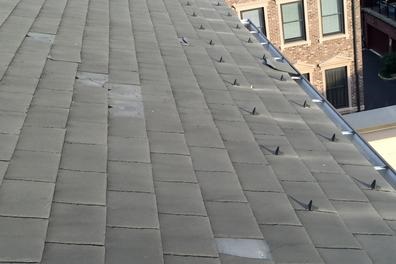
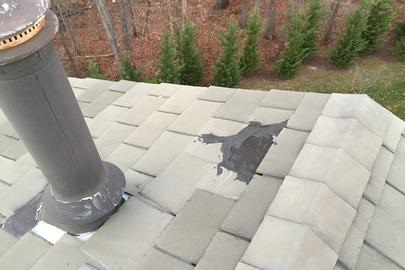
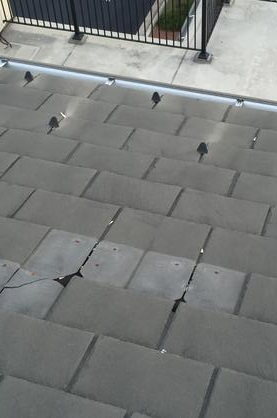
ROOFTOP RAKE BOARDS
AZEK is used as ‘rake boards’ on our rooftops – rake boards are found on the rooftop wall that separates one living unit from its neighbor. The pictures on this page illustrate some examples of the shrinking and expansion of these rake boards and the problems that creates.
Owners can determine if they have this problem by engaging a handyman. Ask them to take pictures that identify any problems they find, to avoid having them exaggerate the situation. Some neighbors have called roofing contractors for this, which is OK, but this is not actually a roofing issue.
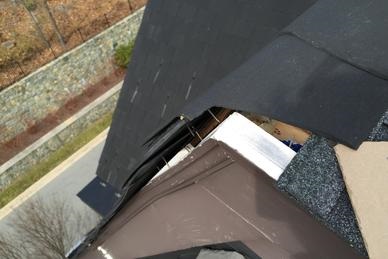
The picture above illustrates the rake board pulling away from the rooftop shingles causing a huge gap at the roof peak. We have observed this condition on several different rooftops.
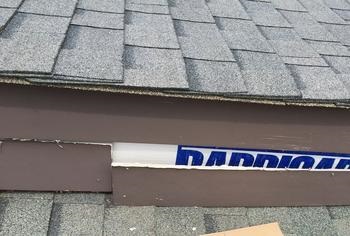
Here the board has pulled away because of the tiny nails that were used to install it.
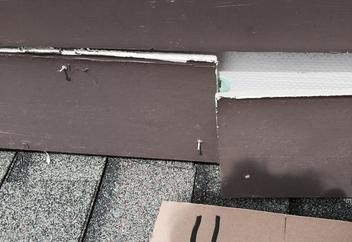
Another example of failure because of the tiny nails used to install the boards.
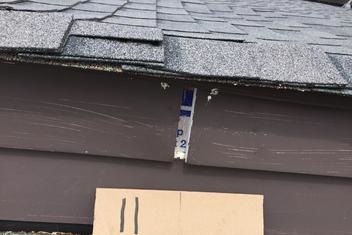
This picture illustrates two things. One, the AZEK has shrunk and pulled apart because it was installed using ‘brads’ rather than the 2 1/4″ screws specified by AZEK (AZEK specifies that brads should not be used). Two, EYA, or their subcontractors, attempted to control the problem by using SIX INCH aluminum screws (note one on each side the gap). These ‘corrective’ screws have been found in many situations throughout the community.
REAR ENTRANCE DOORWAYS
The rear entranceway doors are installed in traditional wood jam structures. These structures are the only ones in our homes that have wood on the exterior. One problem with wood is that it is susceptible to rot unless it is properly maintained by frequent and careful painting.
One place on these structures that has been a particular problem is on the lower, outer section of the wood casing. The cause is that the aluminum tread on the door sill has ridges that hold water and that water lies against the lower section of the wood casing causing it to rot. It is usually not noticed until it’s too late. The other part of the exterior door entranceway that is a potential wood rot issue is the around the two glass pieces located above these doors. Both of these should be monitored, and carefully painted as required.
AZEK HOUSE TRIM MATERIAL
All of the exterior trim on our houses is made of a synthetic wood substitute product manufactured by AZEK. (See exceptions under Rear Entranceway doors). It is a paintable product that will not rot, as wood might.
There is a common AZEK problem throughout the community. As a synthetic product, the AZEK material is subject to expansion and contraction. And because the builder did not follow the AZEK installation specification properly, the result of the expansion and contraction has caused AZEK trim pieces to pull away from where they were attached.
The most prevalent of these is in homes with darker paint colors, as they absorb more heat than lighter colors. And the most common areas where this trim has pulled away is on rooftops where the trim is used along the side of slopping roof edges (these are called rake boards). Depending upon where and how badly these rake boards have pulled away, they can cause leaks and they can be used as nesting sites for birds. When being repainted, AZEK recommends a heat blocking additive be used in the paint.